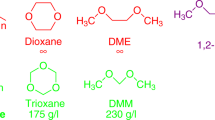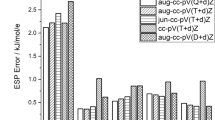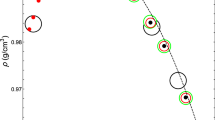Abstract
THE almost linear relation found empirically by Coomber1,2 between the dielectric constant ε and internal pressure pi for several non-polar liquids appears so far to have received no theoretical justification. By making some assumptions it is possible to show that a simple explanation follows from the nature of intermolecular forces. The internal pressure of a liquid is defined as  where E is the potential energy of N molecules occupying a liquid volume V at absolute temperature T. Hildebrand and Scott3,4 have shown that E may be written in the form −a(T).V−n where n is approximately unity for many organic dielectric liquids5, a(T) being slightly dependent on temperature, but not volume, so that pi = n.a(T).V−n−1. If molecular repulsion is assumed5 to contribute negligibly to E, then for non-polar liquids E is due only to the attractive dispersion forces of London5. According to London, the dispersion energy of a molecular pair having random mutual orientation and separation r may be written −3/4.I.α2.f(r), where f(r) = r−6 for monatomic atoms and is a more complicated function for polyatomic molecules; α and I are the atomic or molecular polarizability and ionization potential respectively. Noting that N molecules consist of 1/2N2 molecular pairs and making the usual assumption that E may be calculated from a pair interaction summation, then a(T) may be factorized into a temperature independent part equal to IN2α2 and a temperature dependent part denoted by b(T) which includes numerical constants of the pair summation arising from the interparticle geometry. Thus
where E is the potential energy of N molecules occupying a liquid volume V at absolute temperature T. Hildebrand and Scott3,4 have shown that E may be written in the form −a(T).V−n where n is approximately unity for many organic dielectric liquids5, a(T) being slightly dependent on temperature, but not volume, so that pi = n.a(T).V−n−1. If molecular repulsion is assumed5 to contribute negligibly to E, then for non-polar liquids E is due only to the attractive dispersion forces of London5. According to London, the dispersion energy of a molecular pair having random mutual orientation and separation r may be written −3/4.I.α2.f(r), where f(r) = r−6 for monatomic atoms and is a more complicated function for polyatomic molecules; α and I are the atomic or molecular polarizability and ionization potential respectively. Noting that N molecules consist of 1/2N2 molecular pairs and making the usual assumption that E may be calculated from a pair interaction summation, then a(T) may be factorized into a temperature independent part equal to IN2α2 and a temperature dependent part denoted by b(T) which includes numerical constants of the pair summation arising from the interparticle geometry. Thus  Assuming the Clausius–Mossoti equation to be valid for non-polar dielectrics, then
Assuming the Clausius–Mossoti equation to be valid for non-polar dielectrics, then  Thus
Thus  For the range 2 < ε < 3, in which most non-polar dielectric liquids lie, the function (ε−1/ε+2)2 can be represented by 0.0975ε − 0.1325 with a maximum error of ±0.2 per cent. Because n differs from unity by typically 0.1 and b varies slowly4 with T, pi is seen to be a linear function of ε, as found by Coomber. Values of I differ from molecule to molecule and so the linear relation found by Coomber between pi and ε for different liquids cannot be explained by the theory above. The theory does, however, predict that dielectric constants when extrapolated to zero pi have a value 1.36 for all liquids for which n = 1. Values of n have been given as 1.09, 1.09, 1.05 and 0.89 for hexane4, carbon tetrachloride4, benzene5 and carbon disulphide5 respectively. Coomber1 (his Fig. 2) has plotted ε against pi for the liquids hexane, carbon tetrachloride, cyclohexane, benzene and carbon disulphide, and finds each graph to be linear as demanded by the above theory. Moreover, these lines intersect the pi = 0 axis at values of 1.35, 1.37, 1.35, 1.40 and 1.54 respectively, compared with the theoretical intercept of 1.36. The large discrepancy in the case of carbon disulphide may be due to neglect of molecular repulsion forces in the theory. Hildebrand4 has shown that its potential energy does not follow the V−1 law in the density range considered by Coomber.
For the range 2 < ε < 3, in which most non-polar dielectric liquids lie, the function (ε−1/ε+2)2 can be represented by 0.0975ε − 0.1325 with a maximum error of ±0.2 per cent. Because n differs from unity by typically 0.1 and b varies slowly4 with T, pi is seen to be a linear function of ε, as found by Coomber. Values of I differ from molecule to molecule and so the linear relation found by Coomber between pi and ε for different liquids cannot be explained by the theory above. The theory does, however, predict that dielectric constants when extrapolated to zero pi have a value 1.36 for all liquids for which n = 1. Values of n have been given as 1.09, 1.09, 1.05 and 0.89 for hexane4, carbon tetrachloride4, benzene5 and carbon disulphide5 respectively. Coomber1 (his Fig. 2) has plotted ε against pi for the liquids hexane, carbon tetrachloride, cyclohexane, benzene and carbon disulphide, and finds each graph to be linear as demanded by the above theory. Moreover, these lines intersect the pi = 0 axis at values of 1.35, 1.37, 1.35, 1.40 and 1.54 respectively, compared with the theoretical intercept of 1.36. The large discrepancy in the case of carbon disulphide may be due to neglect of molecular repulsion forces in the theory. Hildebrand4 has shown that its potential energy does not follow the V−1 law in the density range considered by Coomber.
This is a preview of subscription content, access via your institution
Access options
Subscribe to this journal
Receive 51 print issues and online access
$199.00 per year
only $3.90 per issue
Buy this article
- Purchase on Springer Link
- Instant access to full article PDF
Prices may be subject to local taxes which are calculated during checkout
Similar content being viewed by others
References
Coomber, D. I., Trans. Faraday Soc., 35, 304 (1939).
Partington, J. R., An Advanced Treatise on Physical Chemistry, 5, 444 (Longmans, London, 1950).
Hildebrand, J. H., and Scott, R. L., Solubility of Non-Electrolytes, 97 (Reinhold, New York, 1950).
Hildebrand, J. H., and Scott, R. L., Regular Solutions, 77 (Prentice-Hall, New Jersey, 1962).
Hirschfelder, J. O., Curtiss, C. F., and Bird, R. B., Molecular Theory of Gases and Liquids, 281 (John Wiley, New York, 1954).
Author information
Authors and Affiliations
Rights and permissions
About this article
Cite this article
MEETEN, G. Theoretical Basis for Coomber's Relationship. Nature 223, 827–828 (1969). https://doi.org/10.1038/223827a0
Received:
Issue Date:
DOI: https://doi.org/10.1038/223827a0
This article is cited by
Comments
By submitting a comment you agree to abide by our Terms and Community Guidelines. If you find something abusive or that does not comply with our terms or guidelines please flag it as inappropriate.



